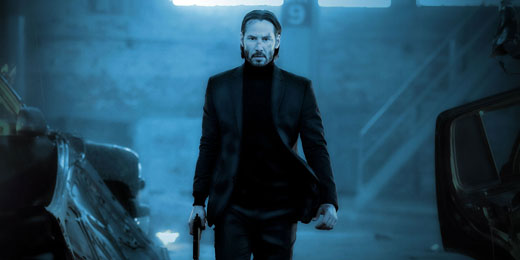Review: John Wick: Chapter 2 (2017)
John Wick: Chapter 2 is one of those rare sequels that expands the world and scope of the original without diminishing it in the process.
One of Charles Bronson’s most celebrated films was the 1974 film Death Wish, a harrowing film where a former soldier is the victim of a home invasion where his wife and daughter are beaten and raped by punks doing it for kicks. Bronson’s character Paul Kersey becomes haunted by his loss and becomes a vigilante to findthese people who wronged him and kill them at all costs. In many ways, the film is a prototype for John Wick, in that guns are treated as the deadly items they are throughout and as an equalizer for justice and an emissary of wrath. John Wick was an unexpected hit on its release, written and directed by stunt coordinators Derek Kolstad and Chad Stahelski; a film that placed you in already established mythology and underworld of gangsters and their secret underworld.
Where John Wick: Chapter Two succeeds is in establishing a franchise out of the first movie’s sketched out framework without negating any of the allure or cool of the first film. While Death Wish 2 and its subsequent Cannon Films based sequels escalated that original film’s foundation to the level of cartoonish farce, John Wick: Chapter Two keeps the foundation of the film and adds elements to open up the world of Wick even further to great effect. This film becomes a bridge from the vigilante based story of the first to a broader James Bond/007 genre universe.
The opening of the film serves as a coda on the original, with Wick reclaiming his stolen car from the chop shop of the Russian uncle of the original film’s antagonist Iosef, played with applomb in a scenery chewing cameo by Peter Stormare. This scene serves to remind us of the force of nature Wick is and plays up the campiness of some of the original film’s claims about the Boogetman Wick; down to the fact that everyone knows Wick killed 3 men in a bar with a pencil. Director Derek Kolstad knows that Wick is basically a superhero so he creates a universe where his god of hitmen meets his match. This is accomplished by the arrival of Santino D’Antonio (played by Italian actor Riccardo Scamarcio). Santino is a full-on Euro trash Bond villain in the mold of A View to a Kill‘s Max Zorin played by Christopher Walken. We learn that Santino and Wick have a blood oath sealed by a marker (a super-sized version of the film’s golden coin currency only with a locket with room for 2 bloody thumbprints). Wick needed Santino’s aid to complete his still unnamed impossible task that he completed for Viggo to escape the hitman lifestyle and would only do so for a favor to be called in later via the marker. Santino is here to collect, but Wick wants nothing but to go back to his quiet life with his pit bull puppy. Santino fixes that with a couple of shots from a rocket propelled grenade launcher that levels Wick’s house and force Wick to claim his marker via a trip to Rome to exterminate a target that Santino cannot touch.
The change in locale lets the creative team expand on the colorful world Wick inhabits; including another clandestine association, The High Table, that stands to become an antagonist in future films. We also see the international version of the Continental Hotel, run by Julius (played with aplomb by seasoned character actor Franco Nero). This leads to some of the best action sequences in the series so far, including one shot through catacombs in Italy that is tense and immersive with Wicxk facing adversaries on all sides in a dark labyrinth. There’s also a great chase fight between Wick and Common’s assassin character Cassian that leads to one of the great payoff scenes in genre cinema in a while. There’s also a great fight choreography sequence in a mirrored environment that hearkens to Enter The Dragon. There’s also a Matrix reunion with Laurence Fishburne – its fun but doesn’t take you out of the movie. The film’s secondary antagonist, a mute assassin played by flavor of the month casting choice Ruby Rose doesn’t land as well as Adrianne Palicki’s Perkins does in the first film, but thankfully she doesn’t have as much screen time as she did in xXx: The Return of Xander Cage. As in the case of the first film, Keanu Reeves’ stoic character grounds the film no matter how ludicrous and unbelievable it seems at times; while there’s things that would be campy in other films, Reeves make it seem real and personal. The end of the film definitely opens the door for future sequels, but if future installments are anything like this one, it will be a welcome path to step into – if only to see what the Boogeyman is up to next.



